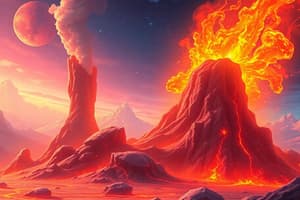Podcast
Questions and Answers
A gasoline's specific gravity is 0.72. What percentage of an equivalent volume of water does the gasoline's weight represent?
A gasoline's specific gravity is 0.72. What percentage of an equivalent volume of water does the gasoline's weight represent?
- 144%
- 28%
- 72% (correct)
- 0.72%
What distinguishes mechanical waves from light waves?
What distinguishes mechanical waves from light waves?
- Light waves require a medium for propagation, while mechanical waves do not.
- Light waves are longitudinal, while mechanical waves are transverse.
- Mechanical waves require a medium for propagation, while light waves do not. (correct)
- Mechanical waves can travel through a vacuum, while light waves cannot.
According to the second law of thermodynamics, which of the following scenarios is impossible without external work?
According to the second law of thermodynamics, which of the following scenarios is impossible without external work?
- Maintaining a constant temperature difference between two reservoirs.
- Heat flowing from a cold reservoir to a hot reservoir. (correct)
- Converting heat entirely into work in a cyclic process.
- Heat flowing from a hot reservoir to a cold reservoir.
In a first-class lever, how are the fulcrum, load, and effort arranged?
In a first-class lever, how are the fulcrum, load, and effort arranged?
Two equal forces act on an object in parallel but opposite directions, applied to two different points. What is this force system called?
Two equal forces act on an object in parallel but opposite directions, applied to two different points. What is this force system called?
How is stress defined in the context of solid materials?
How is stress defined in the context of solid materials?
What factors determine the pressure exerted by a column of liquid?
What factors determine the pressure exerted by a column of liquid?
How do speed and velocity differ?
How do speed and velocity differ?
Why is understanding gyroscopic rigidity important in engineering applications?
Why is understanding gyroscopic rigidity important in engineering applications?
What phenomenon occurs when a light wave transitions from one medium to another?
What phenomenon occurs when a light wave transitions from one medium to another?
Flashcards
What is Electromagnetic Radiation (EMR)?
What is Electromagnetic Radiation (EMR)?
The emission of energy from the surface of most objects, related to accelerating charged particles.
Radiation
Radiation
Heat transfer that does not require a medium.
Second law of thermodynamics
Second law of thermodynamics
Heat cannot flow from a cooler to a warmer body; it flows from warmer to cooler.
What is Force?
What is Force?
Signup and view all the flashcards
What is stress?
What is stress?
Signup and view all the flashcards
What is Period?
What is Period?
Signup and view all the flashcards
Define: Specific heat
Define: Specific heat
Signup and view all the flashcards
What kind of wave is a sound wave?
What kind of wave is a sound wave?
Signup and view all the flashcards
What is the general gas law formula derived from?
What is the general gas law formula derived from?
Signup and view all the flashcards
When a lightwave hits water, what occurs?
When a lightwave hits water, what occurs?
Signup and view all the flashcards
Study Notes
- Heat is a form of energy and its release can do useful work.
- Thermal energy is the term for heat.
- Specific gravity is determined by comparing the density of liquids to water, using comparative densities or specific gravities.
- Gasoline with a specific gravity of 0.72 weighs 72% of the same amount of water.
- Atoms constitutes the smallest form of matter.
Electrons in Shells
- The maximum number of electrons in each shell of an atom equals 2n^2, where n represents the shell number.
Electromagnetic Radiation
- Electromagnetic radiation refers to the emission of energy from the surface of most objects and the acceleration of charged particles
Light Waves vs. Mechanical Waves
- Mechanical waves need a medium like air, water, or rope to travel through.
- Light waves, a type of electromagnetic wave, don't require a medium.
- Radiation is a type of heat transfer that doesn't require a medium.
- The second law of thermodynamics states that heat flows from a warmer body to a cooler body.
- Pascal's law describes pressure traveling in all directions in liquid kinetics.
- A force is anything that can produce a change in a body's state of motion.
Mechanical Advantage
- Mechanical advantage is calculated as load/effort or energy output/energy input.
- A crowbar exemplifies a first-class lever, with the fulcrum positioned between the load and the effort.
- A couple is two equal forces acting in parallel but opposite directions on two different points of a body.
- Stress refers to the force acting through a section of solid material, measured as force per unit area.
- Strain represents the deformation of a material resulting from stress.
- The pressure exerted by a column of liquid is determined by the vertical height of the column, gravity, and fluid density.
- Density is defined as mass per unit volume of a substance.
- Specific gravity is calculated as the density of a substance divided by the density of water.
- Water is the substance to which the weight of another substance is compared when calculating specific gravity.
- Speed describes the rate of change in distance with respect to time, while velocity describes the rate of change in displacement with respect to time.
- Force equals mass times acceleration (F = ma).
- Displacement refers to an object's position relative to its origin, distinct from distance, which is the total length traveled.
- Centripetal force pulls an object moving in a circular motion towards the center.
- The period in motion refers to the time it takes for one complete repetition or cycle, typically measured in seconds.
- A Brayton cycle engine refers to a gas turbine engine.
- Joule is the SI unit for all forms of energy and it provides the capacity for work to be done.
- Potential energy is stored energy. friction
Friction Types
- Static
- Sliding
- Rolling
Momentum Types
- Linear
- Angular
- Linear momentum measures the tendency of a moving body to continue in a straight line.
- Angular momentum measures the tendency of a rotating body to continue spinning.
- Efficiency ratio is the work output divided by the work input.
- If 100 joules of work input results in 90 joules of output, the efficiency is 90%.
- Impulse is the change in momentum of a body when a force is applied, altering its state of motion.
Gyroscope Principles
- Inertia (rigidity in space)
- Precession
- Gyroscopic rigidity is the property of a rotating mass resisting changes to its plane of rotation.
- Precession refers to the change in the plane of rotation caused by an external force.
- Viscosity is the stiffness of a fluid and its resistance to flow.
- The properties of oil with a low viscosity index do not change much over a wide range of operating temperatures.
- Static pressure decreases if velocity increases.
- Conduction is the transfer of heat through physical contact between bodies with different heat levels.
- Specific heat is the number of calories needed to raise the temperature of 1 gram of a substance by 1 degree Celsius.
Temperature Units
- Celsius
- Kelvin
- K = °C + 273
- °C = K - 273
- The general gas law formula combines Boyle's and Charles' laws as P1V1/T1 = P2V2/T2 using absolute temperature and pressure values.
- The angle of reflection equals the angle of incidence.
- Refraction occurs when a light wave hits water.
- Total internal reflection is the important phenomenon for optical fiber.
- Sound waves are compression waves using mechanical action of molecules to transfer action through a medium.
- The amplitude determines the intensity of sound.
- Two similar sound waves arriving at the ear simultaneously but out of phase will cancel each other out.
Studying That Suits You
Use AI to generate personalized quizzes and flashcards to suit your learning preferences.




